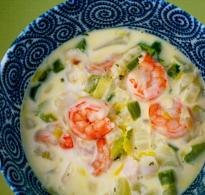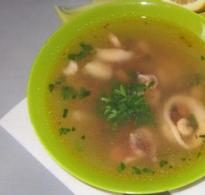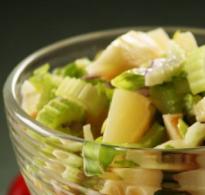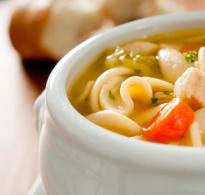Conditions and terms of storage of cold sauces. Rules for the release and storage of sauces
The quality of the sauce is determined according to the consistency, color, taste, smell. When evaluating the properties of sauces with fillers (onion, onion with gherkins, etc.), the shape of the cut and the amount of filler are taken into account.
Hot sauces with flour must have the density of watery sour cream (liquid sauces), be elastic, homogeneous, without lumps of boiled flour and parts of unmashed vegetables. Sauces of medium density, used for baking, have the consistency of thick sour cream. A thick white marinade for stuffing should look like a stringy semolina.
Vegetables that are part of the sauce in the form of a filler should be finely and neatly chopped, evenly distributed in the sauce, soft. There should be no film on the surface of the sauce.
The hollandaise sauce should have a smooth consistency, with no grains or flakes of curdled protein. There should be no grease on the surface of the sauce.
In polish and cracker sauces, the oil should be clear. The eggs for the Polish sauce are coarsely chopped.
Oil should not appear on the surface of mayonnaise; uniform consistency.
Vegetables in marinades should be neatly chopped, soft; horseradish for sauce finely grated.
The color of the sauce should be characteristic of each group of sauces: red - from brown to brownish red; white - from white to slightly grayish; tomato - red. Milk and sour cream sauces - from white to light cream, sour cream with tomato - pink, mushroom - brown, marinade with tomato - orange-red, mayonnaise - white with a yellow tint. The color depends on the products used and the adherence to the technological process.
The taste and smell of the sauce are the main indicators of its quality. For sauces on broths, a pronounced taste of meat, fish, mushrooms with the smell of browned vegetables and seasonings is characteristic.
The main red sauce and its derivatives should have a meaty taste with a sweet and sour taste and smell of onions, carrots, parsley, peppers, bay leaves.
White sauces on meat broth should have the taste of broths with a slight smell of white roots and onions, with a slightly sour aftertaste. The taste of tomato sauce is a pronounced sweet and sour.
Fish sauces should have a sharp specific smell of fish, white roots and spices.
Mushroom sauces - pronounced aroma of mushrooms.
Dairy and sour cream sauces should taste like milk and sour cream. You can not use burnt milk or very sour sour cream for their preparation.
Unacceptable defects in sauces with flour are: the aroma of raw flour and stickiness, the taste and smell of burnt flour, the presence of a huge amount of salt, the taste and aroma of raw, tomato puree.
Egg-butter sauces and sugar marinade have a slightly sour taste and aroma of butter.
Marinades must have a sour-spicy taste, aroma of vinegar, vegetables and spices. The taste of raw tomato puree and a very sour taste are unacceptable.
Marinade sauce and its derivatives should not have a bitter aftertaste and be very spicy, and horseradish sauce with vinegar should not be bitter or slightly spicy.
The main hot sauces are stored in a water bath at temperatures up to 80°C for 3 to 4 hours. The main sauces can be stored for up to 3 days. To do this, they are cooled to room temperature and placed in a refrigerator at a temperature of 0--5°C. Sour cream sauces are stored at a temperature of 75°C for no more than 2 hours from the moment of preparation. Dairy liquid sauce - hot at a temperature of 65--70 ° C for no more than 1--1.5 hours, since during long-term storage it darkens due to caramelization of milk sugar. Thick milk sauce should be stored refrigerated at a temperature of 5 ° C for no more than a day. Milk sauces of medium density are not subject to storage; they are prepared immediately before use. Polish and cracker sauces can be stored for up to 2 hours. Butter mixtures are stored in the refrigerator for several days. To increase the shelf life, they are wrapped in parchment, cellophane or plastic wrap. Mayonnaise of industrial production is stored at a temperature of 5°C for 3 months. Mayonnaise of own production and salad dressings are stored in the refrigerator for 1-2 days, marinades and horseradish sauce - chilled for 2-3 days.
industrial sauces
The food industry produces various sauces,] and many of them have a very spicy taste (tkema? Li, Southern sauce, curry, hunting, etc.). Serve them in non-| in large quantities to such dishes as kebabs, kebabs, etc., or used as additives in the manufacture of cooking sauces.
Use of industrial sauces By-.\ allows you to expand the range of sauces used in public catering.
Mayonnaise. They are used to prepare salads and other dishes, or derivatives are prepared based on them.
Sauce spicy tomato. Prepare it from fresh tomatoes| or tomato puree with the addition of sugar, vinegar, salt, onion, "garlic and spices. Used in the manufacture of meat,] fish and vegetable dishes.
Cuban sauce. It is produced by evaporation midors with sugar, garlic, salt, vinegar, spices.] Add to meat sauces and mayonnaises. The sauce can be used when serving meat, fish and vegetable dishes, as well! for dressing borscht and cabbage soup.
Ketchups. They are also made from tomatoes or tomato puree with various additives, but their tomato content is lower. To give the necessary consistency: thickeners (modified starches, etc.) are added to ketchups.
South Sauce. It has a very spicy taste and a strong spicy aroma. A sauce is prepared from soy fermented hydrolyzate with the addition of applesauce, tomato paste, liver, vegetable oil, spices, spices, onions, garlic, raisins, vinegar and wine (Madeira). Served with oriental dishes, added to red meat sauces and mayonnaise.
Sauce tkemali. It is prepared from puree of tkemali plums with the addition of basil, cilantro, garlic and red hot pepper. It has a sharp sour taste. Served with Caucasian cuisine.
Fruit sauces. They are prepared from fresh ripe apples, apricots, peaches and other fruits. Used in the manufacture and serving of cereals and flour dishes, or mayonnaise is added to the sauce.
In addition to ready-to-eat sauces, the food industry produces white sauce concentrates, mushroom sauces and their derivatives. They are a powder that is
Chapter 2. Sauces
before use, dilute with water in the right amount, and boil for 2-3 minutes, then add butter. The raw materials for sauce concentrates are dry meat, mushrooms, vegetables, browned flour, tomato powder, milk powder, sugar, salt, citric acid, spices, monosodium glutamate. They keep up to 4 months.
The quality of the sauce is determined by consistency, color, taste, aroma. When assessing the quality of sauces with fillers (onion, onion with gherkins, etc.), the shape of the cut and the amount of filler are taken into account.
Hot sauces with flour must have consistency liquid sour cream (liquid sauces), be elastic, homogeneous, without lumps of brewed flour and particles of unmashed vegetables. Medium-thick sauces used for baking have the consistency of thick sour cream. Thick milk sauce for stuffing should be similar to viscous semolina.
Vegetables that are part of the sauce in the form of a filler should be finely and neatly chopped, evenly distributed in the sauce, soft. There should be no film on the surface of the sauce.
The hollandaise sauce should have a smooth consistency, with no grains or flakes of curdled protein. There should be no grease on the surface of the sauce.
In polish and cracker sauces, the oil should be clear. The eggs for the Polish sauce are coarsely chopped.
Oil should not appear on the surface of mayonnaise; uniform consistency.
Vegetables in marinades should be neatly chopped, soft; horseradish for sauce - finely grated.
Sauce color should be characteristic for each group of sauces: red - from brown to brownish red; white - from white to slightly grayish; tomato - red. Milk and sour cream sauces - from white to light cream, sour cream with tomato - pink, mushroom - brown, marinade with tomato - orange-red, mayonnaise - white with a yellow tint. The color depends on the products used and the adherence to the technological process.
Taste and the smell of the sauce - the main indicators of its quality. For sauces on broths, a pronounced taste of meat, fish, mushrooms with the smell of browned vegetables and seasonings is characteristic.
Section III. Cooking technology
Red sauce basic and its derivatives must have! meat taste with a sweet and sour taste and the smell of onions, carrots, parsley, pepper, bay leaf.
White sauces in meat broth should taste boules; onov with a slight smell of white roots and onions, with a slightly sour taste. The taste of tomato sauce is pronounced sweet and sour.
Fish sauces should have a sharp specific smell of fish, white roots and spices.
Mushroom sauces - pronounced aroma of mushrooms.
Dairy and sour cream sauces should taste like milk and sour cream. You can not use burnt milk or very sour sour cream for their preparation.
Unacceptable defects in sauces with flour are: the smell of raw flour and stickiness, the taste and smell of burnt flour, the presence of a large amount of salt, the taste and smell of raw, tomato puree.
Egg-butter sauces and cracker sauce have a slightly sour taste and aroma of butter.
Marinades should have a sour-spicy taste, aroma | vinegar, vegetables and spices. The taste of raw tomato puree and too sour taste are unacceptable.
Mayonnaise sauce and its derivatives should not have a bitter taste and be too spicy, and horseradish sauce with vinegar1 should not be bitter or not spicy enough.
Store the main hot sauces in a water bath at temperatures up to 80 "C for 3 to 4 hours. The main sauces can be stored for up to 3 days. To do this, they are cooled to room temperature and placed in a refrigerator at a temperature of 0-5" C. Sour cream sauces are stored at a temperature of 75°C for no more than 2 hours from the moment of preparation. Dairy liquid sauce - hot at a temperature of 65-7 (GS no more than 1-1.5 hours, since during long-term storage it darkens due to caramelization of milk sugar. Thick milk sauce should be stored chilled at a temperature of 5 "C for no more than a day. Dairy sauces medium density are not subject to storage, they are prepared immediately before use.Polish and cracker sauces can be stored for up to 2 hours.Oil mixtures are stored in the refrigerator for several days.To increase the shelf life, they are wrapped in parchment, cellophane or plastic wrap.Industrial-made mayonnaise is stored at a temperature 5°C for 3 months Mayonnaise of own production and salad dressings are stored in the refrigerator for 1-2 days, marinades and horseradish sauce - chilled for 2-3 days.
The value of vegetable dishes and side dishes in nutrition is determined primarily by the chemical composition of vegetables and, first of all, by the content of carbohydrates. So, dishes and side dishes from potatoes serve as the most important source of starch. A significant amount of sugars contain dishes from beets, carrots, green peas.
Especially great is the importance of vegetable dishes and side dishes as a source of valuable minerals. Most vegetables are dominated by alkaline ash elements (potassium, sodium, calcium, etc.), so dishes from them help maintain the acid-base balance in the body, since acidic elements predominate in meat, fish, cereals, legumes. In addition, the ratio of calcium and phosphorus in many vegetables is close to optimal. Dishes from vegetables, especially from beets, are a source of hematopoietic trace elements (copper, manganese, zinc, cobalt).
Although vitamins are partially lost during heat treatment, vegetable dishes and side dishes cover the main part of the body's need for vitamin C and a significant proportion of B vitamins. Parsley, dill, onion greens, which are added when serving, significantly increase the C-vitamin activity of dishes.
Despite the low content and inferiority of most vegetable proteins, vegetable dishes serve as an additional source of them. With the joint thermal RB treatment of vegetables with meat, fish, eggs, cottage cheese and other protein products, the secretion of gastric juice almost doubles and the digestion of animal proteins improves.
Section III. Cooking technology
Chapter 3. Dishes and side dishes from vegetables and mushrooms
Flavoring, coloring and aromatic substances contained in vegetables contribute to increased appetite, allow you to diversify your diet.
Vegetable dishes are prepared for self-serving in the diet of breakfast, lunch or dinner and side dishes for meat and fish dishes.
Depending on the type of heat treatment, boiled, stewed, fried, stewed, baked vegetable dishes are distinguished.
Vegetable side dishes can be simple and complex. Simple side dishes consist of one type of vegetable, and complex ones consist of several. For complex side dishes, vegetables are selected so that they blend well in taste and color. With the help of a side dish, you can balance the nutritional value of the dish as a whole, regulate its mass and volume.
Meat dishes* are usually served with side dishes of any vegetable. At the same time, side dishes with a delicate taste are more suitable for lean meat dishes: boiled potatoes, mashed potatoes, vegetables in milk sauce. For dishes of fatty meat and poultry, it is better to serve more spicy side dishes - stewed cabbage, stewed vegetables with tomato sauce. Green peas, boiled potatoes, mashed potatoes are served with boiled meat as a side dish. For fried meat - fried potatoes, complex side dishes. For boiled and stewed fish - boiled potatoes, mashed potatoes. Side dishes of cabbage, rutabaga, turnips are usually not served with fish dishes.
Features of decoration with sauces
Mushroom sauces are not independent dishes. They are used to improve the aroma, taste, appearance of dishes. Sauces are served in special dishes - gravy boats, rosettes and other small dishes. Sauces are also used to decorate dishes. There are many techniques for drawing sauces. From ordinary simple strokes to whole compositions. The sauces themselves are not just released, they are often decorated with a bunch of curly parsley, such a simple way adds appetizing and unusual. Also, very often, a piece, slice or small part of the product, which serves as the basis for its preparation, is carefully placed on the surface of the sauce so that it does not fall through or turn over.
Rules for the release and storage of sauces
Sauces are judged on consistency, color and taste. They have a uniform consistency, varying degrees of density depending on the amount of flour, liquid and other incoming products, which must be finely chopped or rubbed. A film on the surface of hot sauces is unacceptable.
The color of sauces corresponds to the main product from which they are prepared. Red sauce should be dark red; white, milky, sour cream - from white to cream; tomato - red, mushroom - brown; marinade - orange, etc.
The taste of sauces should be similar to those of the used broths (meat, fish, mushroom) or milk and sour cream with some deviations; red sauce - with a sweet and sour taste and smell of roots; white - with a slightly noticeable smell of roots; tomato - with a sweet and sour taste. Milk with a burnt smell and too sour sour cream should not be used to make sauces.
Before serving, hot sauces are stored in a water bath (bain-marie) in a container with a lid. To prevent the formation of a film during storage, sauces should be stirred periodically or pieces of butter should be placed on the surface of the sauce.
The storage temperature of different sauces is not the same. Depending on the type of sauce, it ranges from 40 to 80 °.
Sauces on meat, fish and mushroom broths can be stored hot in a water bath (bain-marie) for no more than 4 hours at a temperature not exceeding 85 °. If sauces need to be stored longer than this, they should be refrigerated and reheated as needed. Chilled and then reheated sauces taste better than long-term hot sauces. Basic sauces as semi-finished products can be stored for 2-3 days at a temperature of 0-5°.
Refrigerated thick milk sauce can be stored for a day; sauce of medium density after production must be used immediately; liquid sauce should be stored for no more than 11/2 hours at a temperature not higher than 65-70 °. At temperatures above this and longer storage, the sauce turns red due to caramelization of sugars.
Sour cream sauces are stored at a temperature of 75 "C for no more than 2 hours from the moment of preparation.
The main defects of sour cream sauces are the use of low-quality sour cream - with high acidity, extraneous flavors or lack of sour cream. In addition, there may be defects depending on the flour passivation - a burnt taste, lumpiness. If the sauce is not boiled well, then the smell of raw sour cream is felt.
Steam sauce. The main white sauce is seasoned with citric acid, boiled and boiled white wine is added. Served with stewed meat dishes, chickens, chickens, veal, etc. You can add a decoction of champignons to it.
White sauce with egg. Egg yolks are rubbed with margarine or butter, cream or broth is added and heated in a water bath (75-80 ° C), stirring continuously. This mixture, with stirring, is added to a hot white sauce (75-80 ° C), seasoned with grated nutmeg, citric acid, and salt. Served with dishes of stewed and boiled veal, chickens, chickens, lamb.
White sauce with vegetables. Carrots, parsley or celery and onions are cut into small cubes and sautéed for 3-5 minutes, a little broth is added and, having covered the dishes with a lid, simmer until tender. Finely chopped turnips and bean pods are boiled separately. Ready vegetables are added to the white sauce, boiled, seasoned with salt, citric acid and oil. Served with dishes of boiled lamb, rabbit, poultry, steam meat cutlets.
7. Requirements for the quality and storage of sauces
The liquid part of sauces with flour should be homogeneous, without lumps; the oil does not flake off. Side dishes introduced into the sauce should be soft, brought to readiness. The taste and aroma of sauces are well expressed.
Hot sauces with flour are stored on a food warmer in a sealed container for no more than 3 hours. Sauces are served for distribution in small batches for sale within 1-1.5 hours. Ready-made cold sauces are served for distribution in quantities that can be sold in 1-2 hours Keep in mind that hollandaise sauces are very unstable, so they should be stored in a water bath at a temperature not exceeding 80 "C.
In restaurants, ceramic and metal gravy boats of various capacities are used to serve sauces.
When culling, first determine the consistency of the sauce, pouring it in a thin stream and tasting it. Most sauces should have the consistency of liquid sour cream when hot.
Then they determine the color, taste and aroma, the consistency of the fillers, the shape of the side dishes and the composition (onions, cucumbers, root crops, etc.). Decisive in the assessment of sauces are taste and aroma. .
Inadmissible defects in sauces: extraneous unpleasant odors and tastes; the smell of raw flour and stickiness (the flour was not passivated); the smell and taste of burnt flour; watery taste and faint smell of meat, fish and poultry (weak broth); salting; smell and taste of raw tomato (badly sautéed tomato); the presence of lumps of brewed flour (flour passivation was brewed with very hot water and not filtered); separation of oil in sauces with egg-butter lezon; the presence of dark grains and a bitter aftertaste (burnt vegetables); poorly peeled vegetables.
Red meat sauces should have a rich meat taste, close to the taste of juice from roasting meat, with a sweet and sour taste, color from brown to brown-red, aroma of sautéed vegetables and spices. The smell of bay leaf should not prevail in the "bouquet".
In sauces with wine, the aroma of wine should be well expressed. Vinegar in sauces should not be felt. In onion sauces, the onion should be finely chopped. These sauces have a strong aroma of sautéed onions and spices. The roots in sauces with fillers should be soft. Overcooked or very dense vegetables are unacceptable.
A defect in mustard sauce is curdled grains of mustard. Fillers (vegetables, onions, capers, gherkins, etc.) should be evenly distributed throughout the mass. Meat white, tomato and sour cream sauces should have the taste of meat white sauces (in meat or chicken broth), with the aroma of sautéed white roots and onions. Steam sauce should have a pleasant sour taste. The consistency is elastic, like cream, without lumps and grains. The color is white or cream. The aroma is delicate, without the smell of bay leaf. The absence of citric acid in the steam sauce, white with egg is considered a defect.
The main defects of sour cream sauces are the use of low-quality sour cream - with high acidity, extraneous flavors or lack of sour cream. In addition, there may be defects depending on the flour passivation - a burnt taste, lumpiness. If the sauce is not boiled well, then the smell of raw sour cream is felt.
Fish sauces should have a characteristic, strongly pronounced taste and aroma of white roots, fish, spices. The main defect is the insufficient concentration of the broth. Fish sauces are bitter if the gills were not removed from the heads of the fish when the broth was boiled, or if the food waste was not washed well. Filler defects are: the presence of pitted olives, poor peeling of root crops, violation of the cut shape, the presence of unpeeled or overripe cucumbers. An incomplete set of fillers is evaluated as a marriage. A particularly frequent violation is the absence of white roots.
7.1 Processes involved in the preparation of the sauce
When preparing a white base sauce, the flour is sautéed with fat. Flour is added to sauces to give a certain consistency. Raw flour gives sauces an unpleasant stickiness and flavor. Therefore, the flour is passivated, i.e. dried without color change at 120C or with color change to light brown at 150C. A higher temperature is not used, as the flour acquires an unpleasant aftertaste of "burnt".
When flour is passed through, partial (at 120C) or almost complete (at 150C) denaturation of proteins occurs. They lose their ability to swell and, when combined with broth (water), do not form gluten.
The appearance of colored products and a specific smell is explained by the reaction of melanoidin formation.
Starch has a significant effect on the consistency of the sauce. During passaging, its dextrinization occurs, while starch grains are partially destroyed and lose their ability to gelatinize. Therefore, the sauces are elastic, non-sticky, with a pleasant aroma.
All processes associated with swelling and gelatinization of starch during further boiling of flour with liquid end after about 20 minutes, so sauces should not be boiled for a long time.
Passage flour can be with or without fat. To obtain fat passivation, the sifted flour is poured into melted fat and heated, stirring continuously. Fat ensures uniform heating of the flour and, upon subsequent dilution with broth, prevents the formation of lumps. Fat passivation is usually diluted with hot broth.
Dry, or fat-free, passivation is prepared by heating the sifted flour with a layer of more than 5 cm. To prepare a large amount of dry passivation, the flour is mixed with salt (up to 20% of the flour mass) and heated while stirring. Salt prevents the formation of lumps when breeding passivation with broth. Dry passivation is diluted with a small amount of broth cooled to 50 ° C in order to avoid premature gelatinization of starch and the formation of lumps.
Depending on the color, red and white passivation is distinguished.
7.1.1 Swelling and gelatinization of starch
Swelling is one of the most important properties of starch, which affects the consistency and shape, volume and yield of finished products.
The quality of the sauce is determined by consistency, color, taste, aroma. For sauces with fillers, the shape of the cut and the density of the filler are taken into account.
Hot sauces with flour should have the consistency of liquid sour cream, be "velvety", homogeneous, without lumps of undissolved flour and particles of unmashed vegetables.
The sauce should lightly coat the spoon as it drips off. Medium-thick sauces used for baking have the consistency of thick sour cream. Thick milk sauce should look like viscous semolina.
Vegetables that are part of the sauce in the form of a filler should be finely and neatly chopped, evenly distributed in the sauce, not overcooked.
There should be no film on the surface of the sauce; for this, sauces are pinched with butter or margarine, that is, small pieces of fat are placed on the surface.
Hollandaise sauce should have a smooth consistency and should not contain grains or flakes of coagulated protein. There should be no oil on the surface of the sauce (sequins of fat). In polish and cracker sauces, the butter should be free of protein clots. Coarsely chopped eggs for Polish sauce. In mayonnaise, oil should not appear on the surface. The consistency is uniform. Marinades should contain properly cut and reasonably soft vegetables. Horseradish for sauce with vinegar is rubbed finely.
The color of the sauce should be characteristic of each group of sauces: for red - from brown to brownish red; for whites - from white to slightly grayish; for tomato - red. Milk and sour cream sauces have a color from white to light cream, sour cream with tomato - pink, mushroom - brown, marinade with tomato - orange-red, mayonnaise - white with a yellow tint. The color depends on the products used and the observance of the sauce preparation technology.
The taste and smell of the sauce are the main indicators of its quality. For sauces on broths, a pronounced taste of meat, fish, mushrooms with the smell of browned vegetables and seasonings is characteristic.
The red main sauce and its derivatives should have a meaty taste with a sweet and sour taste and smell of onions, carrots, parsley, peppers, bay leaves. White sauces should have the taste of broths with a subtle smell of white roots and onions, with a slightly sour aftertaste. Tomato sauce has a pronounced sweet and sour taste. Fish sauces should have a sharp, specific smell of fish, white roots and spices, mushroom sauces - the taste of mushrooms and browned onions with the smell of flour. Dairy and sour cream sauces should taste like milk and sour cream. You can not use burnt milk or very sour sour cream for their preparation.
In sauces with flour, unacceptable defects are: the smell of raw flour and stickiness, the taste and smell of burnt flour, the presence of a large amount of salt, the taste and smell of raw tomato puree.
Egg-butter sauces and cracker sauce have a slightly sour taste and aroma of butter.
Marinades should have a sour-spicy taste, aroma of vinegar, vegetables, spices. The taste of raw tomato puree and too sour taste are unacceptable.
Mayonnaise sauce and its derivatives should not be bitter or too spicy, and horseradish sauce with vinegar should not be bitter or not spicy enough.
The main hot sauces are stored in a water bath at temperatures up to 80 ° C for 3 to 4 hours. The surface of the sauce is pinched with butter, the dishes with the sauce are covered with a lid. Basic sauces can be stored for up to three days. To do this, they are cooled to room temperature and placed in a refrigerator at a temperature of 0-5°C. When storing sauces cold, their taste and smell are preserved much better than when stored hot.
Sour cream sauces are stored at a temperature of 75°C for no more than 2 hours from the moment of preparation. Dairy liquid sauce is stored hot at a temperature of 65-70 ° C for no more than 1-1.5 hours, since during longer storage it darkens due to caramelization of milk sugar - lactose; and the taste of the sauce also deteriorates. Thick milk sauce is stored refrigerated for no more than a day at a temperature of 5 ° C. Milk sauces of medium thickness are not subject to storage and are prepared immediately before use. Polish and cracker sauces can be stored for up to 2 hours.
Oil mixtures are stored in the refrigerator for several days. To increase the shelf life, the formed oil mixtures are wrapped in parchment, foil or plastic wrap. It is impossible to store oil mixtures for a long time, since the surface of the oil is oxidized by atmospheric oxygen and turns yellow under the influence of light. This also leads to a deterioration in taste.
Table mayonnaise of industrial preparation is stored at a temperature of 18°C for up to 45 days, and at a temperature of 5°C for 3 months. Mayonnaise sauce prepared at a catering establishment, its derivative sauces, as well as salad dressings are stored for 1-2 days at a temperature of 10-15 ° C in non-oxidizing dishes, dressings - in bottles.
Marinades and horseradish sauce are stored refrigerated for 2-3 days in the same container with a closed lid.
Questions and tasks for repetition
1. On what basis are sauces classified?
2. What sautés and broths are used to make sauces?
3. Draw up a flow chart for the preparation of a red main sauce.
4. How are white base sauces made with meat and fish broth?
5. Draw up a flow chart for the preparation of tomato sauce.
6. How much flour is needed to make 5 liters of medium thick milk sauce?
7. What dishes use sour cream sauce and its derivatives?
8. Draw up technological schemes for the preparation of sauces based on butter.
9. Name the amount of products needed to prepare 1000 g of salad dressing, mustard dressing.
10. How is vegetable marinade with tomato prepared and why is it used?
11. Draw up a technological scheme for the preparation of fish jelly.
12. How are sweet apricot and apple sauces prepared?






